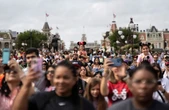The United States has almost 2 million people behind bars in prisons, jails and detention centers—the largest such population in any country. Although incarcerated people are locked away from the outside world, they are even more vulnerable to the impacts of disasters, such as hurricanes and wildfires, than the rest of society.
People who are incarcerated can’t take protective actions, such as evacuating or securing their belongings. They have no say in decisions that the system makes for them. Instead, they must depend on staff and administrators to protect their health and safety.
In September 2024, for example, Hurricane Helene made landfall in Florida, triggering mandatory evacuations in 20 counties and emergency declarations in 61 counties along its path. Despite a mandatory evacuation in Wakulla County, the populations of two state prisons and a county jail were not evacuated.
As Helene traveled northward, 2,000 incarcerated people were evacuated from prisons in North Carolina, but only after the storm damaged local water and power sources.
Just two weeks later, Hurricane Milton hit Florida. Two jails, in Manatee and Pinellas counties, were under mandatory evacuation orders but were not evacuated.
There are no current reports of deaths or injuries among the incarcerated during either of these storms. However, such casualties often go unreported or underreported.
"If you choose to stay in one of those evacuation areas, you are going to die," Tampa's mayor said.But Florida’s incarcerated residents have no choice. 21,000+ people are locked up in counties with mandatory evacuation orders, per @theappeal's analysis. https://t.co/EbC5XXv4YV
We study environmental exposures and hazards from the perspectives of public health, sociology and planning. In a recent study, we worked with our community research partner, the Lioness Justice Impacted Women’s Alliance, to better understand how disasters affect incarcerated women and nonbinary and transgender people.
Participants described how prison environments and policies created traumatic experiences for them during disasters. They emphasized how powerless they felt being unable to make decisions for themselves, or even to get information about what was happening outside the walls of their cells.
Complexity of evacuation and sheltering
Prisons and jails, and people who work inside them, often are figuratively and literally “out of sight, out of mind.” In past disasters, including hurricanes and wildfires, incarcerated people have suffered because prison systems did not prioritize their health and safety. Emergency plans and research studies often neglect incarcerated people and the facilities that house them.
This problem was evident during Hurricane Helene. After running water systems failed at Mountain View Correctional Institution in Spruce Pine, North Carolina, the prison rationed bottled water, leaving individuals to decide whether to use it for drinking or hygiene. According to family members, some people held at the prison had to use plastic bags after their toilets failed and store bags of waste in their cells for up to five days.
Planning for and conducting evacuations of prisons is complex. By design, these facilities make it difficult or impossible for a large number of people to rapidly leave the site. Prisons don’t typically have enough vehicles to transport entire incarcerated populations at once, particularly if they need specialized vehicles due to security concerns or medical conditions.
During Hurricane Katrina in 2005, Orleans Parish Prison—the New Orleans city jail—was not evacuated, even though it was in a mandatory evacuation zone. Some incarcerated adults and youth were abandoned in chest-high floodwaters, without access to medical care, clean water, or food.
Deciding where to take incarcerated people is also a unique challenge for emergency management and correctional agencies. The prisons that incarcerated people are evacuated to must have sufficient resources to care for the influx of people, and must be at a comparable security level to the facilities from which the evacuees came. Incarcerated people cannot be placed in shelters with the general public.
After Hurricane Katrina, some 1,100 incarcerated people were taken to the Broad Street overpass in central New Orleans to await transfers to other facilities. They were guarded there for several days by law enforcement officers, in harsh conditions, exposed to the weather and without food, water or proper sanitation.
Being left behind during an evacuation is traumatic for incarcerated people. One participant in our study described being told that her unit would evacuate before a hurricane hit Texas, only to learn hours later that they would not be moving:
“[The major] came in . . . she said, ‘Ladies, I’m so sorry, they are not evacuating.’ . . . I remember thinking, I’ve been gone from my family for this long and we are fixing to get hit by a damn hurricane . . . like we’re not leaving? . . . They didn’t have anywhere for us to go, and they wanted to evacuate us. . . . It felt ugly.”
“[The major] came in . . . she said, ‘Ladies, I’m so sorry, they are not evacuating.’ . . . I remember thinking, I’ve been gone from my family for this long and we are fixing to get hit by a damn hurricane . . . like we’re not leaving? . . . They didn’t have anywhere for us to go, and they wanted to evacuate us. . . . It felt ugly.”
Disproportionate health impacts
People who are incarcerated in the U.S. tend to be significantly less healthy than the overall population. This can be due to many factors, including lower education levels and a lack of access to safe, high-quality housing and supportive social networks.
Incarcerated people have higher rates of chronic diseases, including diabetes, hypertension, asthma, and substance use disorders. The incarcerated population is aging, and incarcerated people are living longer, resulting in higher rates of chronic health issues such as dementia, impaired mobility, and hearing loss.
Being incarcerated may not have caused these health problems, but it can worsen them. Overcrowding in prisons and jails can significantly limit access to health care, exacerbating existing health challenges.
The prison where California keeps *terminally ill* prisoners to receive hospice care is inside the wildfire evacuation zone–and not being evacuated. "They are breathing in fire and smoke, and they have nowhere to run" https://t.co/CBwJKVATEw
Compounded trauma
Disasters increase the mental health challenges that incarcerated people experience day to day—a toxic blend of feelings of helplessness, vulnerability and social isolation. Social networks that people develop in prison are important sources of emotional support, fostering connections, and improving incarcerated people’s mental health.
Evacuations disrupt these social networks and support systems, inside and outside of prison. The effects persist long after people are released from prison, jail, or detention, and can manifest as fear, anxiety, isolation, and lack of trust.
Our research, as well as reports from recent events like Hurricane Helene, underscores the need for policy changes. In our view, jails, prisons, and detention centers should have comprehensive emergency plans. These plans should address issues including communication, staffing and transportation needs, and the need for peer support and protective actions.
We also see an urgent need for policies and programs that ensure incarcerated people will have access to support services during evacuations, including health care and safeguards against sexual violence. For incarcerated people with physical, cognitive, or mental health conditions, facilities should provide information in ways that reflect those people’s needs, such as flashing lights or digital displays for deaf individuals, and alarms and audio messaging for blind individuals. In our view, these steps would make disaster response and recovery efforts more equitable and safer for everyone in harm’s way.
Benika Dixon is an assistant professor of public health at Texas A&M University.
J. Carlee Purdum is an assistant professor of sociology at the University of Houston.
Tara Goddard is an assistant professor of landscape architecture & urban planning at Texas A&M University.
This article is republished from The Conversation under a Creative Commons license. Read the original article.








No comments